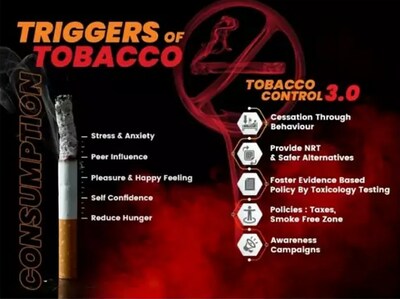India is the 2nd largest tobacco using population in the world
NEW DELHI, April 30, 2024 – A recent report by KPMG Assurance and Consulting Services LLP, in collaboration with ET Edge titled, ‘Human-centric approach to tobacco control’, revealed that India ranks the 2nd largest tobacco using population in the world with 27% of Indian adults engaged in tobacco consumption. The report states that it is imperative and critical to have a holistic roadmap towards tobacco control that is entwined to reduce tobacco induced harm. Offering tobacco users a diverse array of less harmful alternatives will aid in an individual’s journey towards quitting tobacco, leading to a 50% estimated reduction of annual deaths globally due to tobacco related diseases by 2060.
India’s tobacco landscape
The report reveals that there
The persistence of tobacco consumption underscores the necessity for India-specific policies which are based on regulations and science. Helping a largeeconomically weak tobacco using population, while trying to enforce globally prescribed tobacco control measures in India is a predicament that the Indian policy makers consistently face. India faces a dual challenge with both, smoking and oral tobacco use rampant according to this report.
Tobacco’s impact on health and economy
Health and economy are intricately interrelated when it comes to the impact of tobacco consumption. As per the report, 25% of the male population surveyed in tier II and III cities faced health issues of which 29% were severe cases; while 50% male respondents in tier I cities mentioned health issues of which 44% were serious cases.
Yet, 81% of the male
India’s strategies for tobacco control
India has been actively implementing stringent
While nation-wide regulations play a crucial role, state-level regulations in India have also emerged as a vital aspect of the country’s comprehensive tobacco control framework. The introduction of Nicotine Replacement Therapy (NRT) in the National List of Essential Medicines (NLEM) by the Union Ministry of Health and Family Welfare was a welcome move that offered harm restriction to the tobacco users. The act of using NRT products,
Global Policies
Global policies and programs designed towards controlling the
The report revealed that the fall in smoking rate is higher with a high access to less harmful alternatives with countries like Japan, UK, New Zealand & Sweden as compared to countries with a limited access to less harmful alternatives like India, Australia & Singapore.
Key recommendations- What more can be done
The report advocates for a shift in approach, referred to as ‘Tobacco Control 3.0’ to achieve a healthier India, investing in science-based solutions for tobacco control is crucial.
According to the report, individuals who are unwilling to quit smoking, should be encouraged to switch to less hazardous alternatives, minimising their overall health risks.
Enhanced focus on making Nicotine Replacement Therapy (NRT) affordable and accessible can further support these individuals to quit. The report suggests enforcement authorities to develop & maintain an exhaustive database of listed & unlisted manufacturers and retailers of tobacco products. Additionally, focus on investing in technology such like
The report further recommends investment in an innovation fund to support research, data collection and impact monitoring. An increase in investment for a nationwide mass media campaign, supported by targeted regional media, to educate smokers, dispelling myths about tobacco use and encouraging their support for cessation will also play an important role.
On the policy front, the report emphasizes on evaluation of less harmful alternatives that align with the government’s goal of
| Key Survey Findings |
|
About ET Edge
ET Edge an Initiative of The Times Group is India’s largest conference and thought leadership company. Since its inception in 2015, ET Edge has been at the forefront of creating unique thought leadership initiatives with the objective to empower multiple sectors, industries, and segments by dispersing critical business knowledge through strategically developed





